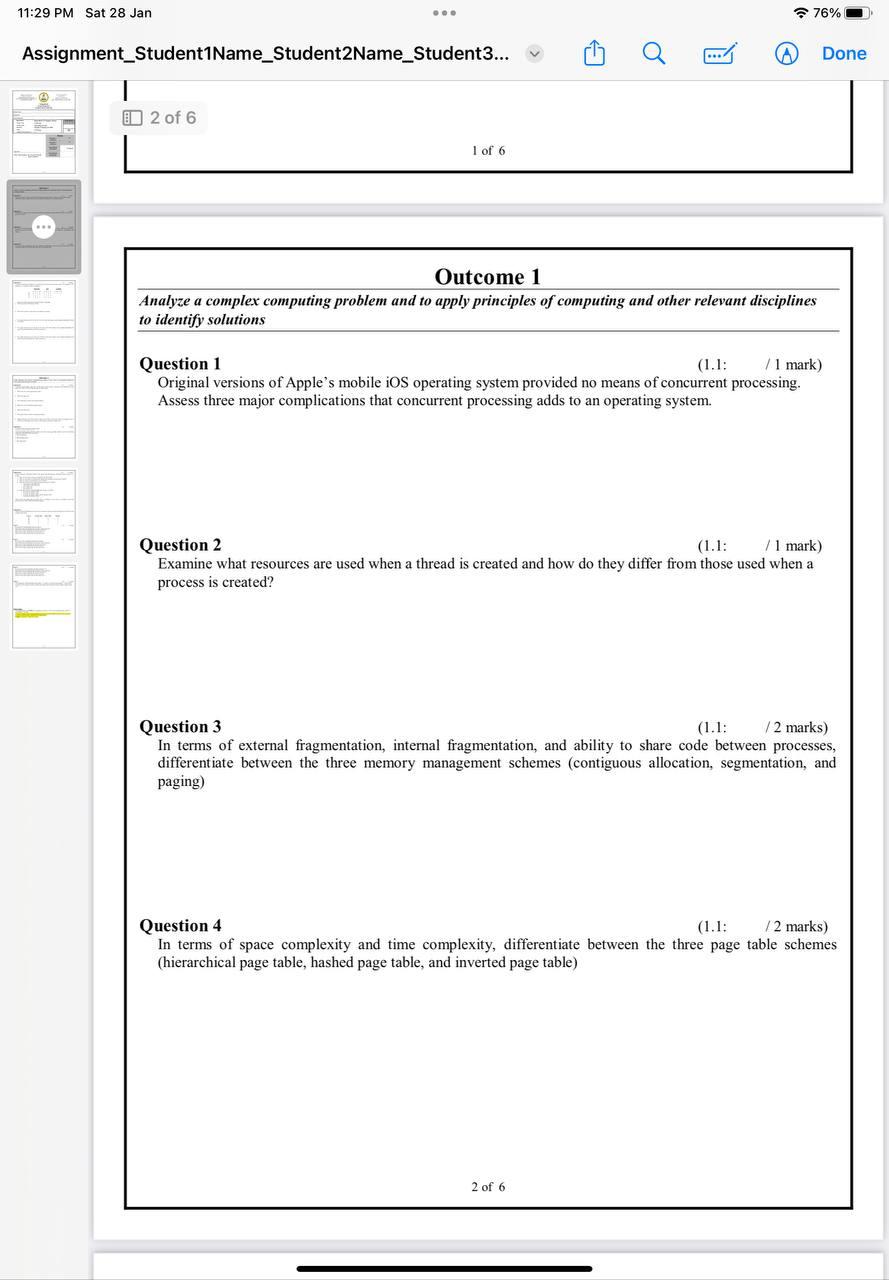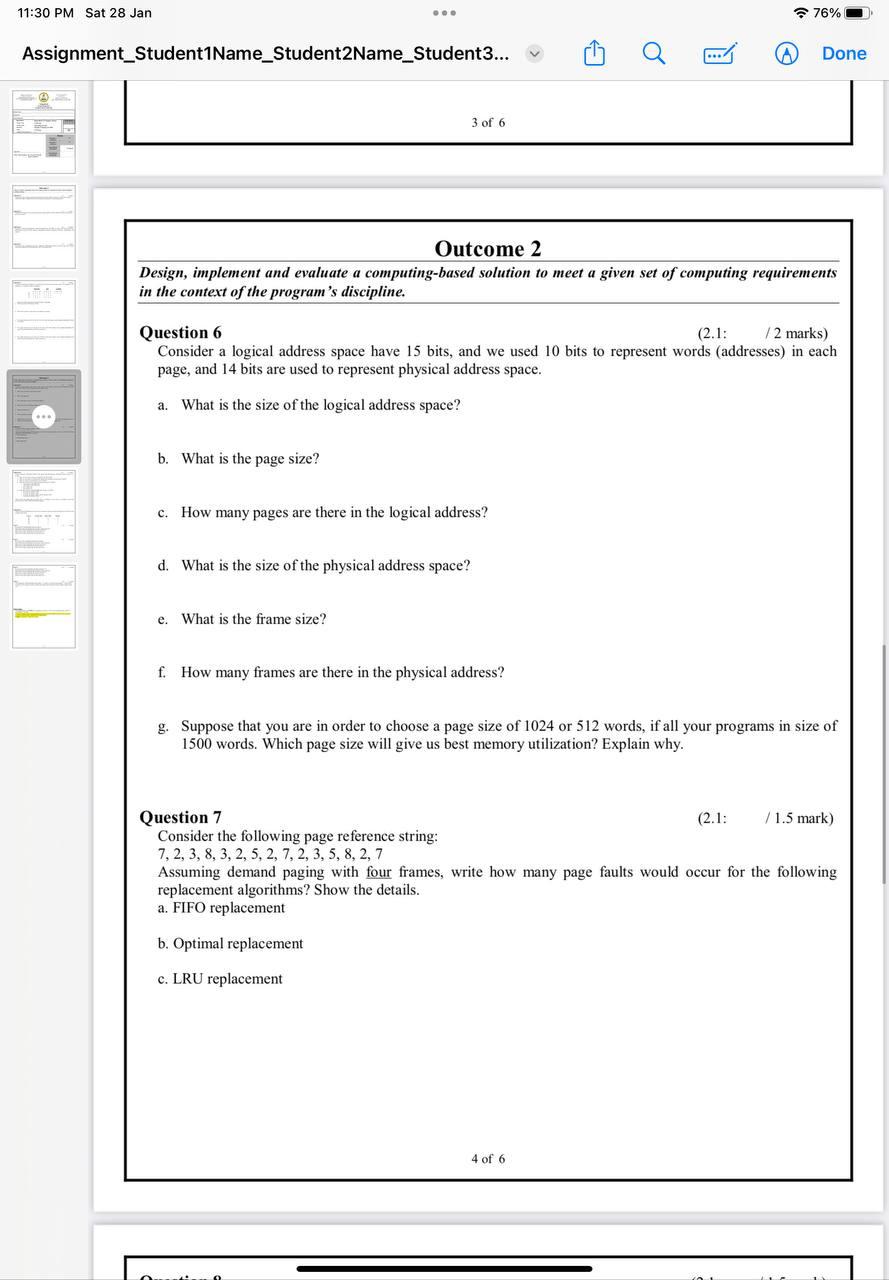Answered step by step
Verified Expert Solution
Question
1 Approved Answer
solve it Question 1 (1.1: /1 mark) Original versions of Apple's mobile iOS operating system provided no means of concurrent processing. Assess three major complications
solve it





Question 1 (1.1: /1 mark) Original versions of Apple's mobile iOS operating system provided no means of concurrent processing. Assess three major complications that concurrent processing adds to an operating system. Question 2 (1.1: /1 mark) Examine what resources are used when a thread is created and how do they differ from those used when a process is created? Question 3 (1.1: /2 marks) In terms of external fragmentation, internal fragmentation, and ability to share code between processes, differentiate between the three memory management schemes (contiguous allocation, segmentation, and paging) Question 4 (1.1: 12 marks) In terms of space complexity and time complexity, differentiate between the three page table schemes (hierarchical page table, hashed page table, and inverted page table) Question 5 (1.2: /4 marks) Consider the following snapshot of a system with 4 processes and 4 resource types A (6 instances), B (5 instances), C ( 6 instances), and D ( 5 instances): Answer the following questions using the banker's algorithm: a. Write the content of the matrices Need? b. Write if the system in a safe state or not? Justify your answer. c. If a request from process P1 arrives for (1,0,1,0), write if the request can be granted immediately? Justify your answer. d. If a request from process P3 arrives for (0,3,0,2), write if the request can be granted immediately the request be granted immediately? Justify your answer. e. If a request from process P0 arrives for (0,0,0,2), write if the request can be granted immediately the request be granted immediately? Justify your answer. in the context of the program's discipline. Question 6 (2.1: /2 marks) Consider a logical address space have 15 bits, and we used 10 bits to represent words (addresses) in each page, and 14 bits are used to represent physical address space. a. What is the size of the logical address space? b. What is the page size? c. How many pages are there in the logical address? d. What is the size of the physical address space? e. What is the frame size? f. How many frames are there in the physical address? g. Suppose that you are in order to choose a page size of 1024 or 512 words, if all your programs in size of 1500 words. Which page size will give us best memory utilization? Explain why. Question 7 (2.1: /1.5 mark) Consider the following page reference string: 7,2,3,8,3,2,5,2,7,2,3,5,8,2,7 Assuming demand paging with four frames, write how many page faults would occur for the following replacement algorithms? Show the details. a. FIFO replacement b. Optimal replacement c. LRU replacement Question 8 (2.1: /1.5 mark) Design a Resource Allocation Graph for the system with the following information about resources in a system: - There are four classes of resource labeled R1, R2, R3 and R4. - There are one instance of resources R3 and R4, and 2 instances of resources R1 and R2. - There are four processes labeled P1, P2, P3 and P4. - There are some resources already allocated to processes, as follows: - One instance of R1 held by P1 - One instance of R1 held by P2 - R3 is held by P4 - R4 is held by P3 - Some processes have requested additional resources, as follows: P1 wants one instance of R2 - P2 wants one instance of R2 - P3 wants one instance of R2, and one instance of R3 - P4 wants one instance of R4 After you draw the graph, find out whether there is a deadlock or not. If there is a deadlock, write which processes case it. If not, write the allocation sequence. Question 9 Suppose that the following processes arrive for execution at the times indicated. Each process will run for the amount of time listed. Part 1 (2.2: /1.5 mark) By using SJF scheduling algorithm (preemptive): Draw Gantt charts that illustrate the execution of these processes. What is the average turnaround time for these processes? What is the average waiting time for these processes? What is the average response time for these processes? Part 2 (2.2: /1.5 mark) By using priority scheduling algorithm (preemptive): Draw Gantt charts that illustrate the execution of these processes. What is the average turnaround time for these processes? What is the average waiting time for these processes? What is the average response time for these processes? What is the average waiting time for these processes? 6 of 6 the average response time for these processes? 5 of 6 Part 3 (2.2: /1.5 mark) By using round-robin scheduling algorithm (quantum =2 ): Draw Gantt charts that illustrate the execution of these processes. What is the average turnaround time for these processes? What is the average waiting time for these processes? What is the average response time for these processes? Part 4 (2.2: /0.5 mark) The waiting time of RR algorithm with quantum =2 is high, if we choose time quantum =5 rather than 2 , examine how this change can affect waiting and response time? Justify why these numbers change in that way. Deliverables: You should submit one WORD file containing your answers "use the same assignment file, DO NOT CONVERT IT TO PDF" ***The file should include your names and IDs in the cover page and should be named exactly as specified: Assignment_Student1Name_Student2Name_Student3Name. Example: Assignment_Amal_Reem_Abeer
Step by Step Solution
There are 3 Steps involved in it
Step: 1

Get Instant Access to Expert-Tailored Solutions
See step-by-step solutions with expert insights and AI powered tools for academic success
Step: 2

Step: 3

Ace Your Homework with AI
Get the answers you need in no time with our AI-driven, step-by-step assistance
Get Started


